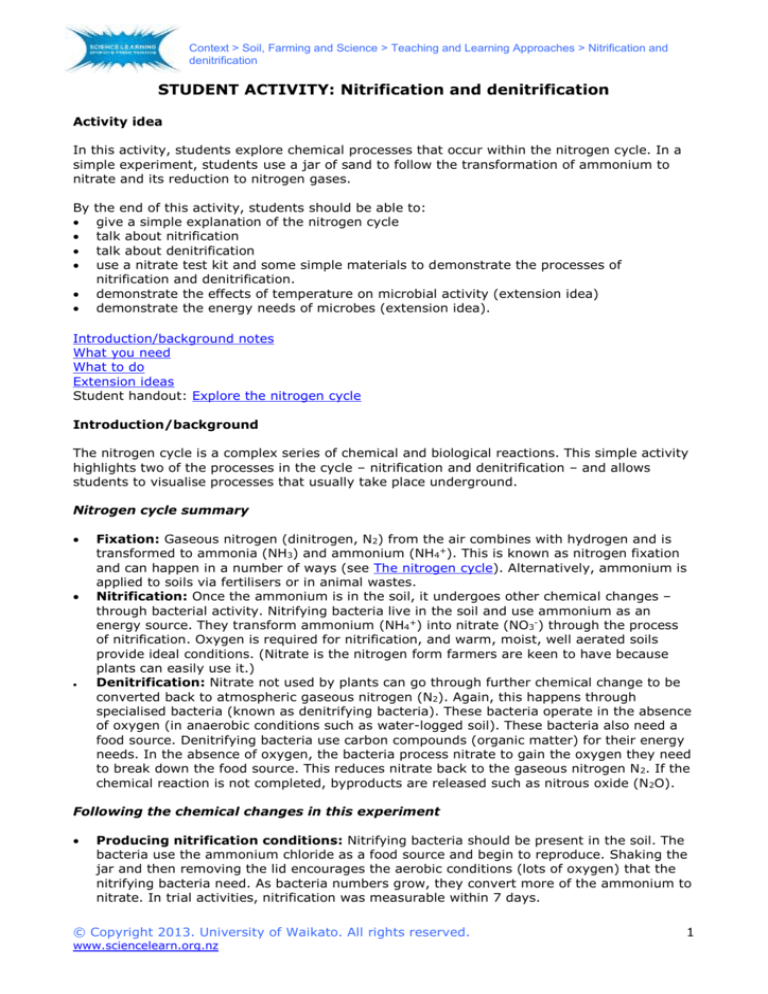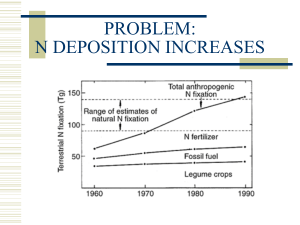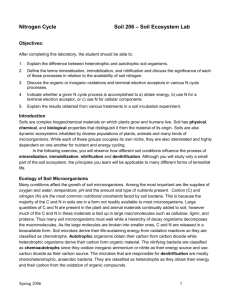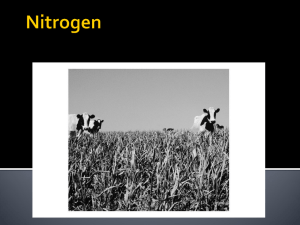
Context > Soil, Farming and Science > Teaching and Learning Approaches > Nitrification and
denitrification
STUDENT ACTIVITY: Nitrification and denitrification
Activity idea
In this activity, students explore chemical processes that occur within the nitrogen cycle. In a
simple experiment, students use a jar of sand to follow the transformation of ammonium to
nitrate and its reduction to nitrogen gases.
By
the end of this activity, students should be able to:
give a simple explanation of the nitrogen cycle
talk about nitrification
talk about denitrification
use a nitrate test kit and some simple materials to demonstrate the processes of
nitrification and denitrification.
demonstrate the effects of temperature on microbial activity (extension idea)
demonstrate the energy needs of microbes (extension idea).
Introduction/background notes
What you need
What to do
Extension ideas
Student handout: Explore the nitrogen cycle
Introduction/background
The nitrogen cycle is a complex series of chemical and biological reactions. This simple activity
highlights two of the processes in the cycle – nitrification and denitrification – and allows
students to visualise processes that usually take place underground.
Nitrogen cycle summary
Fixation: Gaseous nitrogen (dinitrogen, N2) from the air combines with hydrogen and is
transformed to ammonia (NH3) and ammonium (NH4+). This is known as nitrogen fixation
and can happen in a number of ways (see The nitrogen cycle). Alternatively, ammonium is
applied to soils via fertilisers or in animal wastes.
Nitrification: Once the ammonium is in the soil, it undergoes other chemical changes –
through bacterial activity. Nitrifying bacteria live in the soil and use ammonium as an
energy source. They transform ammonium (NH4+) into nitrate (NO3-) through the process
of nitrification. Oxygen is required for nitrification, and warm, moist, well aerated soils
provide ideal conditions. (Nitrate is the nitrogen form farmers are keen to have because
plants can easily use it.)
Denitrification: Nitrate not used by plants can go through further chemical change to be
converted back to atmospheric gaseous nitrogen (N2). Again, this happens through
specialised bacteria (known as denitrifying bacteria). These bacteria operate in the absence
of oxygen (in anaerobic conditions such as water-logged soil). These bacteria also need a
food source. Denitrifying bacteria use carbon compounds (organic matter) for their energy
needs. In the absence of oxygen, the bacteria process nitrate to gain the oxygen they need
to break down the food source. This reduces nitrate back to the gaseous nitrogen N 2. If the
chemical reaction is not completed, byproducts are released such as nitrous oxide (N 2O).
Following the chemical changes in this experiment
Producing nitrification conditions: Nitrifying bacteria should be present in the soil. The
bacteria use the ammonium chloride as a food source and begin to reproduce. Shaking the
jar and then removing the lid encourages the aerobic conditions (lots of oxygen) that the
nitrifying bacteria need. As bacteria numbers grow, they convert more of the ammonium to
nitrate. In trial activities, nitrification was measurable within 7 days.
© Copyright 2013. University of Waikato. All rights reserved.
www.sciencelearn.org.nz
1
Context > Soil, Farming and Science > Teaching and Learning Approaches > Nitrification and
denitrification
Producing denitrification conditions: Once there is a significant amount of nitrate
(50 ppm), we can change the conditions to begin the denitrification process. We do this by
adding a food source (the sugar) for the denitrifying bacteria and by creating anaerobic
conditions (put the lid on and don’t shake the jar). As the students continue to test the
solution, they will notice a reduction in nitrate concentration. This is because the nitrate
has been transformed into gaseous forms of nitrogen.
Parts per million: The test kit measures the nitrate in parts per million (ppm). If you’d
like your students to explore this concept further, the student activity Exploring small doses
from the Toxins context helps students to understand what parts per million really means.
What you need
1 litre jar with a lid (e.g. 1 kg
peanut butter jar)
2 litre plastic bottle (e.g. milk
bottle)
700 g clean sand. Rinse the sand
several times until the water runs
clear. It is important to remove any
organic matter and dirt. The
solution in the jar needs to be clear
for nitrate testing.
5 g sugar
⅛ teaspoon garden soil (not potting
mix or sterile soil)
2 litres of water
Ruler
Electronic scale
Plastic syringe (10 ml or greater)
0.4 g ammonium chloride. If your school does not have a chemistry department, consider
contacting your local high school to obtain this item.
High-range nitrate test kit (to detect at least 50 ppm). These can be purchased online or
through an aquarium retailer for about $20.
Copies of the student handout Explore the nitrogen cycle
Access to the articles The nitrogen cycle, Inhibiting nitrification, Inhibiting nitrous oxide
emissions and Denitrification beds – a creative approach
Access to the interactive The terrestrial nitrogen cycle
What to do
1. Hand out copies of the student handout Explore the nitrogen cycle and use it to help
students work through the activity.
2. Ask lots of questions. Keep the students thinking and relating what they do back to the
nitrogen cycle. Some questions might be:
Why are we using ammonium chloride as a food source for the nitrifying bacteria? (In
soil, nitrifying bacteria use naturally occurring ammonium. Ammonium chloride is an
easily obtained substitute.)
Why is soil added? (Nitrifying bacteria live in soil. The tiny amount of soil used in this
activity is a way of introducing the bacteria to the activity. We just use a small amount
so the water does not get too cloudy.)
Why is sugar added? (Sugar is a carbon compound used by denitrifying bacteria for
food.)
Why does the jar need to be shaken for one part of the experiment and not shaken for
the other? (Nitrifying bacteria require oxygen; shaking the jar helps to promote aerobic
conditions – lots of oxygen. Denitrifying bacteria use nitrate instead of oxygen; we
don’t shake the jar to encourage an anaerobic environment.)
How many days did it take before the ammonium began to be transformed to nitrate?
© Copyright 2013. University of Waikato. All rights reserved.
www.sciencelearn.org.nz
2
Context > Soil, Farming and Science > Teaching and Learning Approaches > Nitrification and
denitrification
How many days did it take for the nitrate to be reduced through denitrification?
Describe how this activity fits into the nitrogen cycle. (Bacteria in the jar transform
ammonium to nitrate through to nitrogen gases, similar to what happens under
ground.)
What are the advantages and disadvantages of denitrification? (Advantage: it
transforms (and so eliminates) excessive nitrate that might otherwise end up in
waterways through run-off and leaching, which could then cause excessive plant growth
leading to eutrophication – see the article Farming and environmental pollution.
Disadvantage: Nitrate may not all be completely reduced to N2 – the potentially harmful
greenhouse gas could be released as a byproduct).
3. Encourage students to graph their results. It may look similar to this.
Extension ideas
1. Using temperature changes
Redo the activity but this time use three jars. Label them jars 1, 2 and 3:
Place jar 1 in the refrigerator (0–5°C).
Place jar 2 at room temperature (15–25°C).
Place jar 3 in an incubated area (30–40°C).
Carry out the experiment, recording results for each of the jars. Graph each set of results.
Compare the differences:
Nitrification may not occur at all in jar 1.
In jar 2, nitrification and denitrification should be similar to the first experiment.
Both these processes should occur at a faster rate in jar 3.
Discuss the implications of temperature on microbial processes:
What happens to the rates of microbial processes in the winter and summer?
© Copyright 2013. University of Waikato. All rights reserved.
www.sciencelearn.org.nz
3
Context > Soil, Farming and Science > Teaching and Learning Approaches > Nitrification and
denitrification
What are the implications for the presence of nitrate in the soil, plant growth, nutrient
leaching and pollution, the need for fertiliser?
Read the article Inhibiting nitrification and discuss the implication temperature may have on
nitrification inhibitors.
Assessment: Students could write about the effect a cold (or warm) spring would have on
recently applied ammonium fertiliser to pastures on a farm.
2. Using energy sources
In nature, nitrifying bacteria use ammonium as an energy source. Denitrifying bacteria use
carbon compounds. Both ammonium and carbon compounds are naturally derived from
organic matter. Sand is generally low in organic matter so we add sugar (carbon source) to
ensure the rapid conversion of nitrate to nitrogen gases in the first activity. Sugar supplies an
immediate source of energy for denitrifying bacteria. Try this activity to understand the energy
needs of bacteria.
Redo the activity using four jars:
Jar 1 – add 5 g of sugar. This is the control. Results will be similar to the initial experiment.
Jar 2 – don’t add any carbon source. Denitrification may occur slowly depending on the
amount of organic matter in the sand.
Jar 3 – add 10 g sugar. Denitrification rates will be considerably faster due to increased
availability of carbon.
Jar 4 – add 2 teaspoons of grass clippings. Grass is a carbon source but must be broken
down before bacteria can use it. The rate of denitrification will be slower.
3. New Zealand research – using the nitrogen cycle to reduce potentially harmful
nitrogen compounds
Read the New Zealand research articles Inhibiting nitrification and Inhibiting nitrous oxide
emissions. How and why are these scientists trying to inhibit the nitrification process?
How does Professor Louis Schipper deal with excessive nitrate in Denitrification beds – a
creative approach?
© Copyright 2013. University of Waikato. All rights reserved.
www.sciencelearn.org.nz
4
Context > Soil, Farming and Science > Teaching and Learning Approaches > Nitrification and
denitrification
Student handout: Explore the nitrogen cycle
1. In pairs, read and discuss the article The nitrogen cycle. Discuss nitrification/denitrification.
How do these processes fit into the nitrogen cycle?
2. In pairs explore the animation The terrestrial nitrogen cycle. Listen to the video clips on
nitrification and denitrification. Discuss until you are clear about these processes. Ask your
partner:
What form of nitrogen is found in soil after fixation?
What happens to this form? How?
What happens to the next form?
How does this happen?
3. Use the scale to measure 0.4 g of ammonium chloride. Place the ammonium chloride in the
2 litre bottle. Fill with water and shake well to dissolve. Label the bottle “Poison: Do not
drink. Ammonium chloride solution”.
4. Pour the sand into the 1 litre jar (should be about half full).
5. Add ⅛ teaspoon of soil to the jar. For best results, use soil from a fertilised lawn or garden.
6. Pour 500 ml of the ammonium chloride solution into the jar, leaving a headspace of 5 cm.
7. Cap the jar and shake vigorously to mix. Allow the contents to settle.
8. This activity works best in a warm environment. Consider keeping the jar in a hot water
cupboard or similar during colder times of the year.
9. Use the nitrate test kit to test the solution for the presence of nitrate. Follow the directions
with the kit. Use the syringe to remove the ammonium chloride solution. The result should
be 0 ppm at this stage. Record the results on the recording sheet.
10. Test for nitrate at the same time daily, if possible. Record all results.
11. Cover the jar and shake daily to add oxygen – promoting aerobic conditions – for
nitrification to take place. (Remove the lid after shaking.)
12. Once the nitrate concentration reaches 50 ppm, add 5 g of sugar to the jar. This introduces
an energy source (food) for denitrifying bacteria. Shake vigorously to mix. Allow contents
to settle. Discontinue shaking the jar to promote anaerobic conditions for denitrification to
take place. Keep the jar capped.
13. Test the solution at the same time daily and record results. End the activity when the
nitrate concentration reaches less than 5 ppm.
14. Graph your results.
© Copyright 2013. University of Waikato. All rights reserved.
www.sciencelearn.org.nz
5
Context > Soil, Farming and Science > Teaching and Learning Approaches > Nitrification and denitrification
Recording sheet: Measuring nitrification and denitrification
Set up the activity as directed.
Test nitrate concentrations daily and record in the nitrification section.
Once the nitrate concentration reaches 50 ppm, add 5 g of sugar and mix well.
Continue daily testing for nitrate until the concentration falls below 5 ppm.
Nitrification
Date
Denitrification
Nitrate measure
© Copyright 2013. University of Waikato. All rights reserved.
www.sciencelearn.org.nz
Date
Nitrate measure
1









